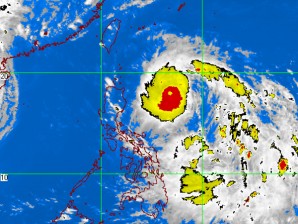
Pagasa MTSAT-EIR Satellite Image for 5 p.m., 30 September 2011
MANILA, Philippines – Typhoon “Quiel” (international codename: Nalgae) has gained more speed and continued to move west toward Tuguegarao as it widened its base, prompting the Philippine Atmospheric, Geophysical and Astronomical Services Administration (Pagasa) to put two provinces in its path – Cagayan and Isabela – under Signal No. 3 Friday.
As of 4 p.m. Friday, Quiel was spotted 490 kilometers east of Tuguegarao city with maintained maximum winds of 140 kilometers per hour near the center and gustiness of up to 170 kilometers per hour, Pagasa said in its bulletin.
Quiel also gained momentum, moving westward at 26 kilometers per hour and was expected to make landfall over the Cagayan-Isabela area early Saturday morning.
Quiel’s diameter increased to 500 kilometers from 400 kilometers and is estimated to bring 15-25 millimeters of rainfall, Pagasa said.
Signal no. 2 was raised in Northern Aurora, Quirino, Ifugao, Mountain Province, Kalinga, Apayao, Calayan and Babuyan Group of Islands, Pagasa said.
Signal no. 1 is up in the rest of Aurora, Nueva Vizcaya, Pangasinan, Benguet, La Union, Ilocos Norte, Ilocos Sur, and Abra.
The southwest monsoon is not expected to induce rain until Saturday afternoon when Quiel will have passed the island of Luzon, Pagasa said.
Due to a high pressure ridge north of the country, Quiel is not expected to change its course northwards.
Meanwhile, Pagasa said that it had no control over the release of water from the dams and only gave recommendations to their operators.
Science and Technology Undersecretary Graciano Yumul said the floods that have swamped Central Luzon were not caused primarily by water that was released from the dams.
The waters that flooded these provinces came from the rain that fell from the mountains, he said.
“Water from the dams can be controlled and calculated but water coming from the mountains cannot be controlled,” Pagasa hydrologist Heraclio Borja said.
Yumul also said the six-hour early warning protocol for opening dam gates was followed.